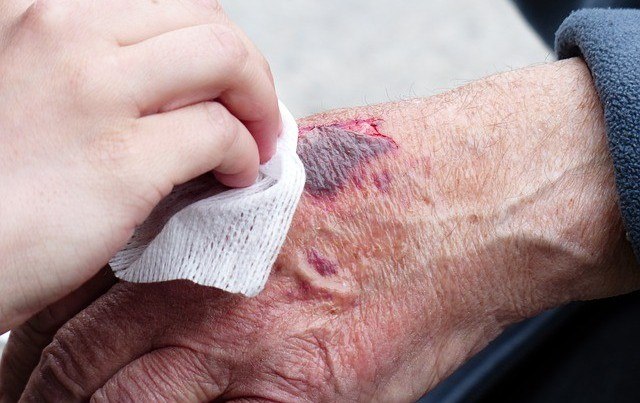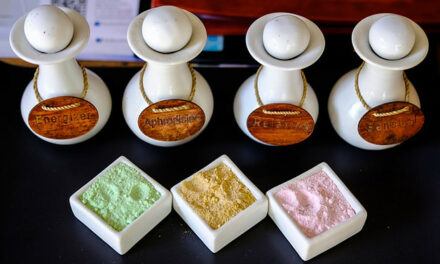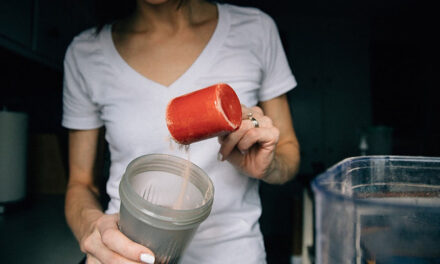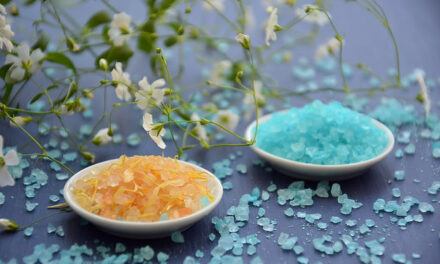Wound healing is a natural body function, which involves all the dynamic processes, which the skin and the tissues under it undergo to heal injuries. Most wounds like minor injuries, little cuts, scrapes and abrasions can easily heal own with little care, but when a wound doesn’t heal, takes time to heal or reoccurs, it is considered to be a chronic wound.
The processes involved in treating chronic wounds can be complex, painful and may take a lot of time for the wound to heal properly. In this article, I provide a useful guide on how to speed up wound healing in chronic slow-healing wounds.
Chronic wounds can affect your health, finance and emotions of a patient and their loved ones. It can cause a lot of persistent pain to a patient, as well as cause damage to the nerve, immobility, low self-esteem, Depression, infection, hospitalization and even death.
Tip: If you experience leg pain due to diabetes, our article about Diabetes Leg Pain Relief might be an useful article to read.
A chronic wound can be as a result of a poor health condition such as Diabetes, vascular diseases and poor blood circulation, poor nutrition that was not noticed or treated. It can also allow for cancerous growth.
To avoid the wound getting infected by bacteria, then infecting the blood (septicemia) or lead to amputation (e.g. as in diabetes), it is vital that you see a healthcare practitioner early and monitor the wound healing well if you have a wound that refuses to heal.
Let’s explore more on chronic wounds and what they really are.
What is a Chronic Wound?
Chronic wounds are those wounds that fail to proceed through the normal healing phases in an orderly manner and time.
The healing process of a wound on the skin follows certain steps and patterns into the recovery. A wound fails to heal if any of the healing steps are disrupted.
Wound Healing Phases
I have noted the normal wound healing phases below.

Inflammatory phase
This is the phase when the blood vessels at the site of the wound constrict, thus preventing or reducing blood loss while allowing blood platelets to gather and build a clot.
Once the clotting is complete, the blood vessels expand to allow blood flow to the wound.
White blood cells flood the wound site to fight microorganisms (e.g. bacteria), and there is an increase of skin cells across the wound.
Fibroblastic phase
In the fibroblastic healing period, the collagen (that is the protein fibre that strengthens the skin) starts to form within the wound.
This process will enable the edges of the wound to shrink together little by little until it closes.
At this stage, capillaries are formed at the site to supply the new skin with blood.
Refining or Maturation phase
At this phase, the body continues to supply collagen to refine the wounded area.
This process may take weeks, months or even years. This is why scars fade after some time and why we must take care of wounds for some time after they have healed.
Most times when wounds are stuck in the inflammation phase of healing or when the healing phase is interrupted, a chronic wound develop, and this is most likely to occur in patients with an underlying medical problem.
Here are the causes of chronic wounds.
Causes of Chronic Wounds
Accident injuries and destroyed tissue
A severe injury or burn, resulting in large and deep wounds may test the limits of your body’s ability to heal itself.
Poor blood circulation
A wound would heal slowly if there is poor blood circulation (or nutrition) at the wound site.
Heart, blood vessels and blood-related sicknesses can cause your wounds to heal slowly.
However, in most of the cases, people suffering from peripheral artery disease (PAD), that is those have narrowed arteries or veins, or venous
insufficiency is the reason for slow-healing wounds due to sluggish blood circulation.
This disorder affects the major veins draining blood from the legs, which transport blood back to the heart.
Venous insufficiency causes the veins to become enlarged, usually resulting in what is called ‘varicose veins’. This prevents the blood from flowing upwards, and the fluid accumulates in the legs, making the legs to swell resulting to skin break down and persistent leg ulceration or poor wound healing on the lower legs. Those are known as venous leg ulcers.
Diabetes
High level of sugar in the bloodstream can damage blood vessels and nerves that supply blood to the feet. The poor circulation affects the oxygen supply and nutrients to tissues, increasing the risk of wounds becoming chronic.
We have already covered Diabetes Wound Care and Treatment in a separate article.
Physical pressure
Immobile people, those who spend a long-time lying-in bed or sitting in a wheelchair, may develop bed sores or pressure ulcers from the pressure put on that parts of their body by their own body weight, which in turn restrict blood flow to that part of the body.
Tip: Did you know How To Choose a Wheelchair Cushion to Prevent Pressure Ulcers? We got that topic covered,
Repetitive Trauma to the Wound
When there is persistent pressure due to bumping, bruising or rubbing against the wounded surface, it is said to be undergoing repetitive trauma.
Repetitive trauma can lengthen the healing process or stop it completely.
Barriers to Wound Healing
Since we have talked about the causes of chronic wounds, it would be wise we also talk about certain factors that can cause a barrier or slow down the wound healing process.
Here they are.
Medical conditions
Underlying medical conditions can form a barrier to wound healing.
Some of such diseases are: diabetes, leprosy, anemia and vascular diseases that restrict blood flow to the area, or any disease that affects the immune system, and cancers.
Dead skin (necrosis)
Dead skin at the wound site and foreign materials can interfere with the wound healing process.
Infection
Wound and cuts (incisions) made during surgeries may become infected and can delay the healing as in this case, instead of the body healing the wound, your body will be fighting the infection.
Bleeding (Hemorrhage)
Continuous bleeding at a wound site will keep the wound open for a long time; and therefore, will result in slow healing. This is common in people with bleeding disorders.
Malnutrition
Poor nutrition is one of the reasons why wounds will not heal. This is because the body may be deprived of the essential nutrients it needs for wound healing.
Vitamin C (to boost your immunity), zinc (to promote cell division), and protein (to build new tissues) are some of such essential items. Your body needs them. Lack of them, therefore eventually lead to delayed wound healing.
Medicine
Certain drugs or treatments used in the management of some medical conditions, even some types of pain medication can interfere with the body’s healing process.
Tip: Reconsider if any of Type 2 Diabetes Home Remedies, Joint Pain Remedies, Back Pain Remedies or any Back-Pain Treatment Options
you are using cause your wounds to heal slowly.
Smoking
Cigarette smoking can delay healing and can increase the risk of wound site complications.
Dryness
Wounds, especially leg ulcers that are exposed to the air, are less likely to heal on time. The reason is that the cells such as skin cells and immune cells involved in healing need a moist environment, and wherein a dry endearment, those cells struggle in working together effectively.
Edema
Oedema occurs when fluid accumulates within your body tissue, or a collects under the skin resulting in swelling at the affected part of the body.
Swelling can be a significant barrier to healing by preventing the flow of nutrients to and from the wound area.
Weakened immune system
Having a weak immune system, as a result of ill health such as cancer, can affect the healing process of wounds.
Wounds often heal more slowly in older adults and people who are malnourished.
How to Care for Slow Healing Wounds to Speed Up Wound Healing
Self-care suggestions for slow-healing wounds include the below.
Review your drugs
Take doctors advice, and if possible, do not take medicines that interfere with the body’s natural healing process. For example, over-the-counter aspirin and other anti-inflammatory drugs could destroy the action of immune system cells. Consult your doctor for a list of medications to avoid.
Tip: Here’s our popular Tips on How To Choose The Best Doctor To Treat Diabetes.
Eat healthy food
Make sure to eat well, including high protein and high fibre food in your diet and eat fresh fruits and vegetables daily. In that way that the body can get the essential nutrients needed to hasten wound healing.
As noted before, vitamin C (to help immunity and the body produce more collagen), vitamin A, copper and zinc are important.
Hydrate well
Drink plenty of water to stay hydrated.
Maintain the wound temperature and wetness
Always keep your wound covered with a clean dressing.
Maintain a warmth at the wound site; wounds heal faster when they are kept warm.
Avoid soaking the wound in water.
When changing dressings, try to be quick because exposing a wound to the open air can drop its temperature, make it dry and may slow healing.
Your hygiene
Always follow hygienic procedures, for example, washing your hands before and after changing your dressings.
Reconsider using antiseptic creams
Antiseptic creams, washes or sprays are poisonous to the cells involved in wound healing, so, do not use them long-term on chronic wounds.
Keep active
Exercise regularly to increases blood circulation, improves general health and speed up wound healing.
Take care of your overall health
Take care of any chronic medical conditions such as diabetes.
Break the bad habits
Stay away from smoking and second-hand smoke.
Avoid scratching
Also, avoid scratching and removing scabs. As noted before, scratching causes repetitive trauma and injury to your healing wounds, so avoid doing it.
Monitor your wound
Check your wound daily and watch out for signs of infection, such as fever, increased pain, or changes in colour or pus discharge or bleeding.
Visit your doctor regularly
Most importantly, follow your doctor’s instruction.
Tip: Have you heard about Negative Pressure Wound Treatment? It can help to heal Pressure Ulcers, Venous Ulcers and Diabetic Ulcers faster.






